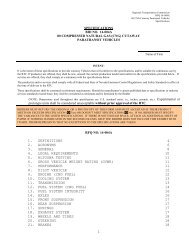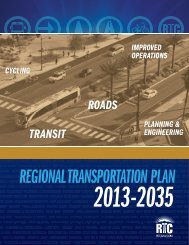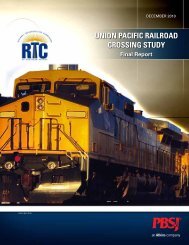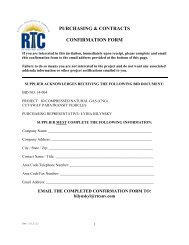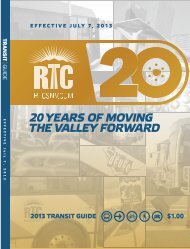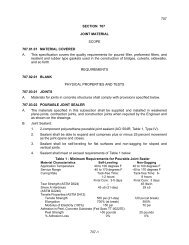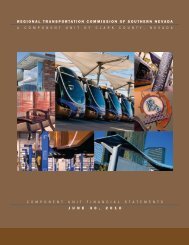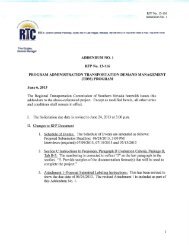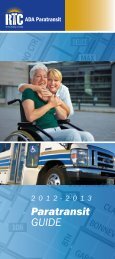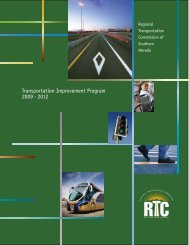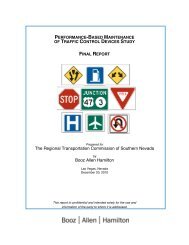(Blue Diamond Road) Corridor Study - Regional Transportation ...
(Blue Diamond Road) Corridor Study - Regional Transportation ...
(Blue Diamond Road) Corridor Study - Regional Transportation ...
You also want an ePaper? Increase the reach of your titles
YUMPU automatically turns print PDFs into web optimized ePapers that Google loves.
4. Evaluation Methodology RTC SR-160 <strong>Corridor</strong> <strong>Study</strong><br />
congested routes. The increasing share of trips between the Pahrump Valley and Las<br />
Vegas is also contributing to the growth in average daily traffic along SR-160. As<br />
described in the prior section, NDOT has completed capacity improvements for<br />
SR-160 which are to be completed in two separate phases.<br />
<br />
The number and type of activity centers – Activity centers represent nodes that<br />
can serve as station sites for any high-capacity transportation system. They also<br />
represent locations where bus service may converge, facilitating transfers between<br />
regional transit and local transit and community shuttle services.<br />
Variables that represent the physical characteristics of the alignment include:<br />
<br />
Right-of-way availability – <strong>Corridor</strong>s may more easily have a dedicated track of<br />
running way when extra right-of-way (beyond what is required for already planned<br />
roadway expansions) is available. <strong>Corridor</strong>s that have wide medians or extra rightof-way<br />
on the sides of roadways for potential queue jumpers or dedicated lanes have<br />
a higher likelihood of accommodating high-end BRT systems or LRT/DMU. The<br />
planned expansion of SR-160 does provide sufficient space for a dedicated transit<br />
running way in some areas An assessment of the feasibility of implementing a<br />
dedicated transit running way is presented in Section 4.<br />
<br />
Pedestrian accessibility – Research on the link between transportation and land<br />
development suggests that the presence of high concentrations of population,<br />
employment sites, and activity centers within walking distance of transit stations<br />
promotes ridership. Alignments are assessed for the design of the pedestrian<br />
network around them and the likelihood that adjacent population clusters and<br />
activity centers will have pedestrian-friendly connections to potential stations. Since<br />
much of the study area has until recently been sparsely developed, with key gaps in<br />
the street network, issues related to pedestrian accessibility have not been central in<br />
the improvement of transportation infrastructure. Pedestrian accessibility is a design<br />
consideration in the conceptual drawings of two Park & Ride facilities (1-1 and 1-4).<br />
The factors described above are evaluated to ensure development of a transit plan for the<br />
<strong>Blue</strong> <strong>Diamond</strong> study area that captures future transit market shares without risking<br />
premature system overcapitalization. To the extent possible, operational considerations<br />
have been woven into the selection of potential station locations, Park & Ride facilities, and<br />
running way treatments. Because of the manner in which development in the study area is<br />
being phased in, a phasing strategy that ramps up service levels based on observed<br />
increases in the transit market is recommended.<br />
To plan for future growth, attention must also be given today to opportunities to reserve<br />
space for future transit-supportive features. Because of the tremendous demand for Bureau<br />
4-2



